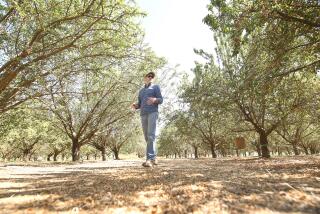Sending in the Swat Team to Fight Cotton Pests
- Share via
Biological pest control seems simple enough: Just find good bugs that like to gobble up the bad bugs that have been chomping on your crop.
The reality is a whole lot more complex, as scientists are learning at the Shafter Cotton Research Station north of Bakersfield.
For example, they’re trying to find non-native parasites that can survive in the San Joaquin Valley and kill aphids that thrive in cotton fields.
“We have found parasites that kill aphids year-round,” says Kris Godfrey, a state Food and Agriculture researcher. “Now, we’re testing species to see which are compatible in our area.”
Rising pesticide costs and two recent bad pest years have contributed to declining profit for cotton and caused growers to increase rotations with such crops as seed alfalfa, tomatoes, melons, sugar beets and other vegetables, said Dan Munk, cotton farm advisor for Fresno County.
The Shafter research is pinpointing two species of tiny wasps. One type imported from Florida is just 1 1/2 millimeters long; the other from Japan is 2 millimeters long.
Tests of those wasps last year were inconclusive, says Godfrey. She ran into a perplexing problem this spring.
“We can’t find them,” she says. “Maybe they don’t like the San Joaquin Valley or they survived [winter] in only small numbers.”
John McLaughlin of the U.S. Department of Agriculture says the imported wasps may just be taking a long time adjusting to California’s climate.
“On the other hand, biological control reduction is a bit of a crapshoot,” McLaughlin says. “So, you don’t release just one species; you try to introduce several.”
With that concept in mind, Godfrey says parasites that eat cotton aphids in other parts of the world will also be brought to Shafter for testing.
Her husband, Larry Godfrey of UC Davis, is looking at aphids from a different perspective--that of the plant.
“We’re trying to see what effects aphids have on plant physiology,” he says.
There is some indication that low levels of aphids may not damage the plant extensively, but there’s also a possibility that aphids inject a toxin or directly affect physiology or photosynthesis.
Larry Godfrey says a study in Fresno County last year showed that a field heavily infested with aphids suffered a drop in the photosynthesis rate after the plant had more than 500 aphids per leaf. The leaf temperature also increased a couple of degrees.
In another attempt to find good bugs, predator mites have been released in an attempt to control damaging spider mites. However, releasing 2,000 beneficial mites per acre didn’t reduce the spider mite population below that of a control plot, says Rami Colfer of UC Davis.
“We’re trying to find what conditions predator mites work best under,” Colfer says. “We’re studying different release rates--do they work? And if so, is it economically feasible?”






